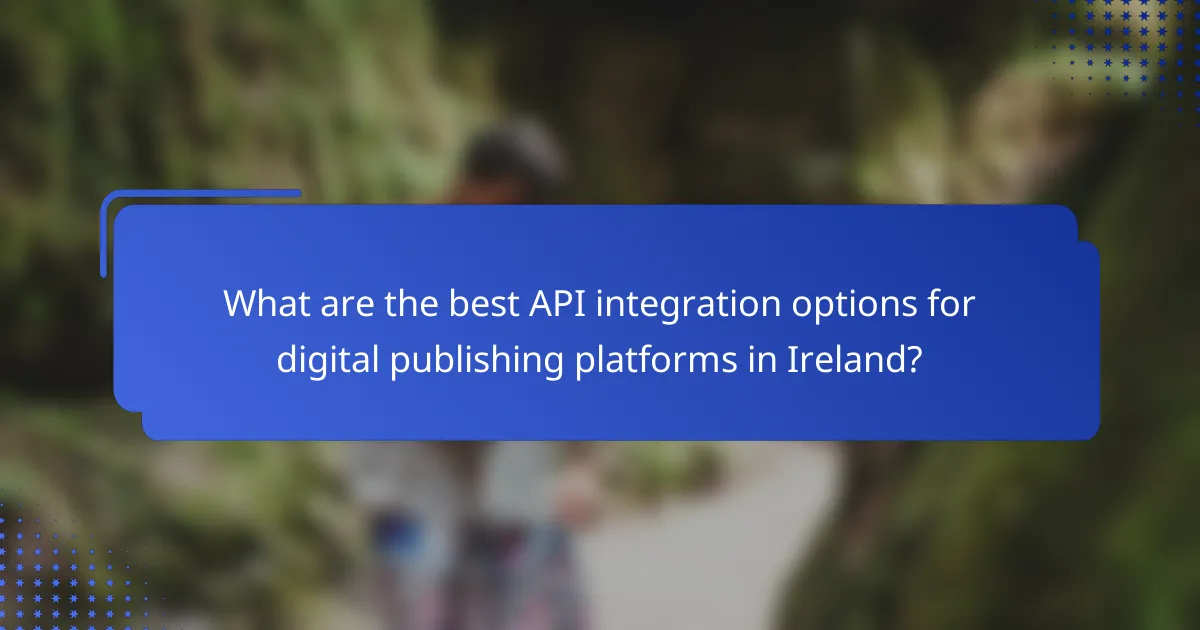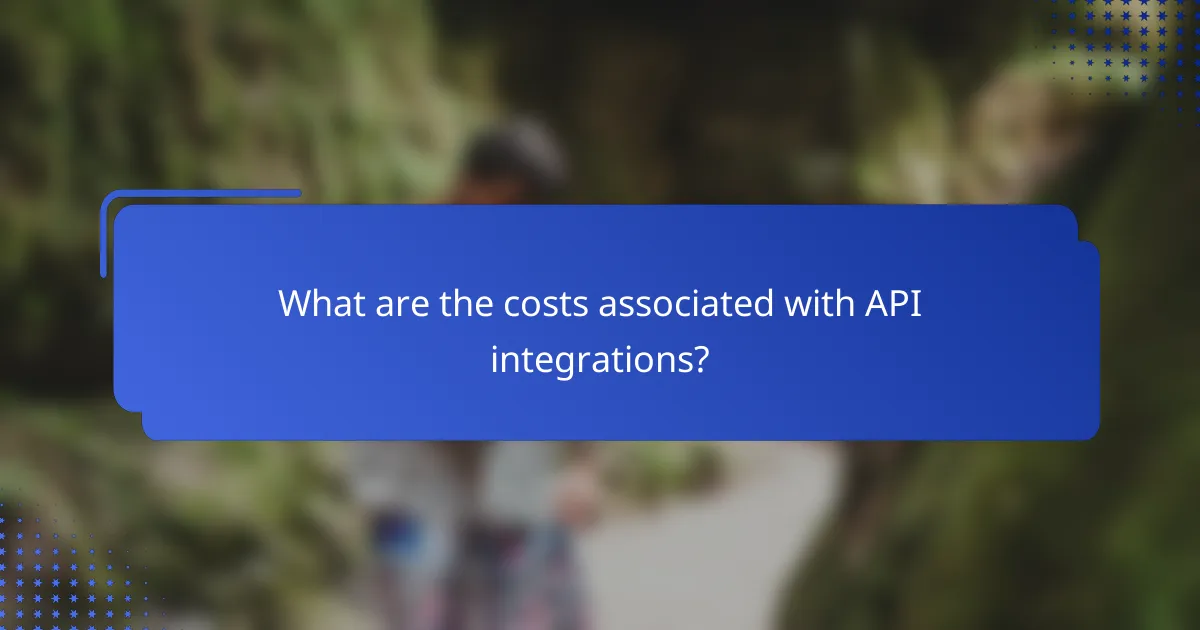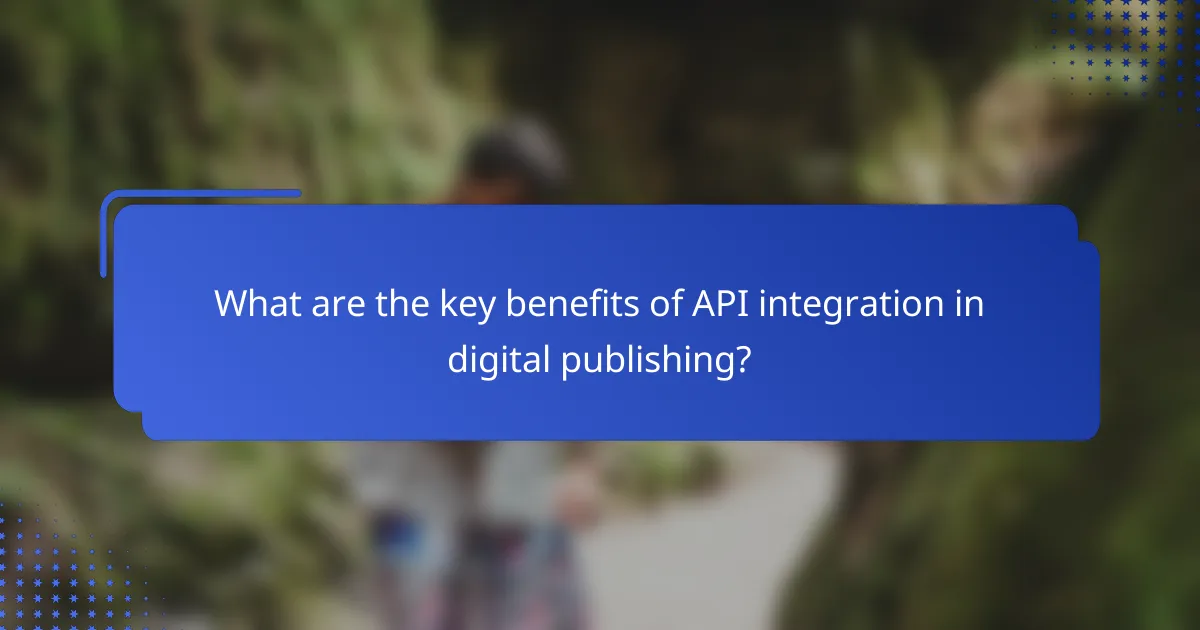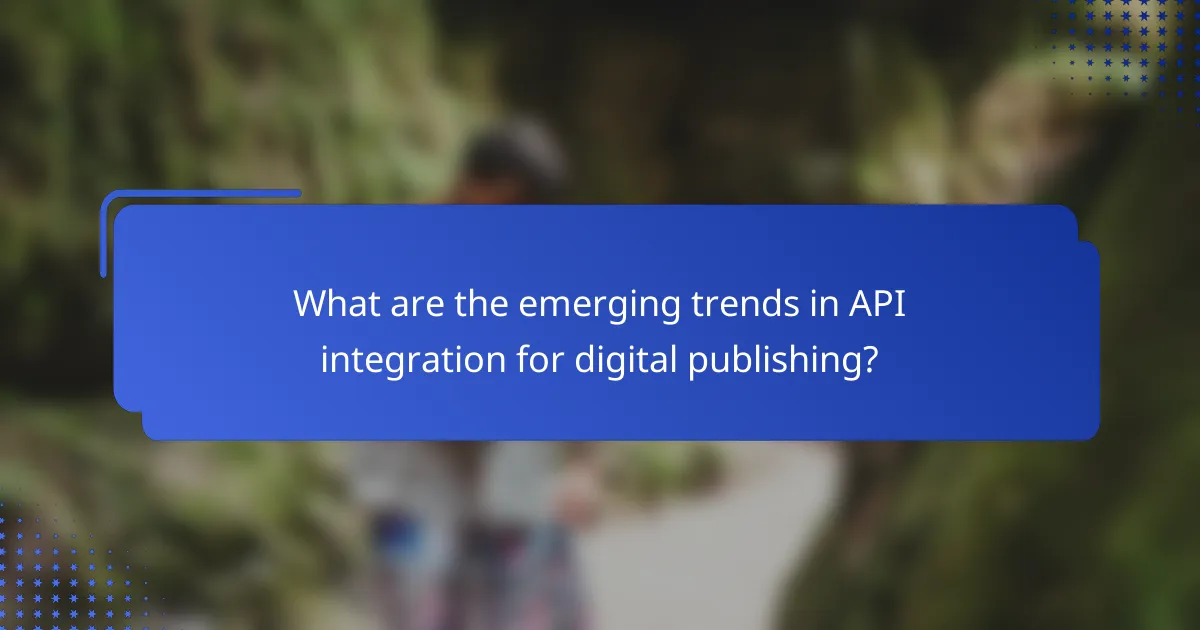In the rapidly evolving landscape of digital publishing, selecting the right API integration is crucial for optimizing content management and distribution. Options such as the WordPress REST API, Contentful API, and Adobe Experience Manager API each bring distinct advantages tailored to diverse publishing needs. A thorough evaluation of these APIs should focus on their scalability, performance, and user-friendliness to ensure they align with your operational requirements.

What are the best API integration options for digital publishing platforms in Ireland?
The best API integration options for digital publishing platforms in Ireland include WordPress REST API, Contentful API, and Adobe Experience Manager API. Each of these options offers unique features and capabilities that can enhance content management and distribution, catering to various needs in the digital publishing landscape.
WordPress REST API
The WordPress REST API allows developers to interact with WordPress sites programmatically. It enables the creation, retrieval, updating, and deletion of content through standard HTTP requests, making it a flexible choice for digital publishers looking to integrate their platforms seamlessly.
When using the WordPress REST API, consider the security implications, such as authentication methods like OAuth or application passwords. This ensures that your content remains protected while allowing authorized applications to access it.
Contentful API
Contentful API is a headless CMS that provides a powerful way to manage content across multiple platforms. It allows users to define content types and deliver content via a simple RESTful interface, making it ideal for publishers who want to maintain a consistent experience across various channels.
One key advantage of Contentful is its flexibility in content modeling. Publishers can create custom content types tailored to their specific needs, which can enhance the overall user experience. However, be mindful of potential costs, as pricing can vary based on usage and features.
Adobe Experience Manager API
Adobe Experience Manager (AEM) API offers a comprehensive solution for managing digital assets and content. It integrates well with other Adobe products, providing a robust environment for large-scale publishing operations. AEM’s API supports both REST and GraphQL, allowing for versatile content retrieval methods.
When considering AEM, evaluate the complexity of implementation and the associated costs, as it is generally more expensive than other options. Ensure that your team has the necessary skills to leverage its full potential, as the learning curve can be steep for new users.

How to evaluate API integration features?
Evaluating API integration features involves assessing how well the API can support your digital publishing needs, including its scalability, performance, and user-friendliness. Key considerations include the API’s ability to handle increasing loads and the quality of its documentation for ease of implementation.
Scalability and performance
Scalability refers to the API’s ability to handle growth, such as increased traffic or data volume. A good API should maintain performance levels even as demand rises, ideally supporting thousands of requests per second without significant latency. Look for APIs that provide metrics on their performance under load, such as response times in low tens of milliseconds.
When evaluating scalability, consider the architecture of the API. RESTful APIs are generally more scalable than SOAP due to their stateless nature. Additionally, check if the API supports caching mechanisms, which can significantly enhance performance by reducing server load.
Ease of use and documentation
Ease of use is crucial for a smooth integration process. Comprehensive documentation should be available, detailing endpoints, authentication methods, and error handling. Well-structured documentation can save developers hours of troubleshooting and help them implement the API more efficiently.
Look for APIs that offer interactive documentation or SDKs in popular programming languages. These resources can simplify the integration process and provide practical examples. Avoid APIs with sparse documentation, as they can lead to confusion and delays in project timelines.

What are the costs associated with API integrations?
The costs associated with API integrations can vary significantly based on the platform, complexity, and ongoing maintenance needs. Key expenses include subscription fees for the platforms used and the development and maintenance costs of the integrations themselves.
Subscription fees for platforms
Subscription fees for digital publishing platforms can range from low monthly rates to several hundred dollars, depending on the features and services offered. For instance, basic plans may start around $20 to $50 per month, while more advanced options with extensive API capabilities can exceed $200 monthly.
When evaluating subscription costs, consider the number of users, the volume of API calls allowed, and any additional features that may be necessary for your publishing needs. Always check for hidden fees or tiered pricing structures that could affect your overall budget.
Development and maintenance costs
Development costs for API integrations can vary widely, typically ranging from a few hundred to several thousand dollars, depending on the complexity of the integration. Factors influencing costs include the need for custom coding, the time required for implementation, and the expertise of the developers involved.
Maintenance costs are another important consideration. These can include ongoing support, updates, and troubleshooting, which might amount to 15-20% of the initial development cost annually. It’s crucial to factor in these recurring expenses when budgeting for API integrations.

What are the key benefits of API integration in digital publishing?
API integration in digital publishing offers significant advantages, including streamlined workflows and improved data accessibility. By connecting various systems, publishers can enhance their operations and deliver content more efficiently.
Improved content management
API integration allows for better content management by enabling seamless communication between different publishing tools and platforms. This connectivity helps automate tasks such as content updates and metadata synchronization, reducing manual effort and errors.
For instance, when a new article is published, an API can automatically update the content across multiple channels, ensuring consistency. This can save time and improve accuracy, allowing teams to focus on creating high-quality content.
Enhanced user experience
Integrating APIs can significantly enhance the user experience by providing personalized content and faster access to information. By leveraging user data, publishers can tailor content recommendations and streamline navigation, making it easier for readers to find what they want.
For example, an API can facilitate real-time updates on trending topics or user preferences, ensuring that the content remains relevant. This responsiveness can lead to increased engagement and satisfaction among users, ultimately driving higher retention rates.

What criteria should be used to select an API integration?
When selecting an API integration for digital publishing platforms, prioritize compatibility, support, and community resources. These criteria ensure that the integration meets your technical needs and provides ongoing assistance for optimal performance.
Compatibility with existing systems
Compatibility is crucial when evaluating API integrations, as it determines how well the new API will work with your current systems. Assess whether the API supports the programming languages, frameworks, and data formats you are already using. For example, if your platform is built on a specific CMS, ensure the API can seamlessly integrate without extensive modifications.
Consider the scalability of the API as well. An API that can grow with your needs will save time and resources in the long run. Look for APIs that offer flexible endpoints and robust documentation to facilitate integration with your existing workflows.
Support and community resources
Robust support and community resources are essential for troubleshooting and optimizing API integrations. Check if the API provider offers comprehensive documentation, tutorials, and responsive customer support. A well-documented API can significantly reduce the learning curve and help you implement it more efficiently.
Additionally, explore community forums and user groups related to the API. A vibrant community can provide valuable insights, share best practices, and help you solve common issues. Engaging with other users can enhance your understanding and usage of the API, making it a more effective tool for your publishing needs.

What are the common challenges in API integration?
API integration in digital publishing platforms often faces several challenges that can hinder efficiency and effectiveness. Key issues include data security concerns and integration complexity, which can impact the overall performance and reliability of the system.
Data security concerns
Data security is a major challenge in API integration, especially when sensitive information is involved. Publishing platforms must ensure that data transmitted through APIs is encrypted and complies with regulations such as GDPR or CCPA to protect user privacy.
To mitigate risks, implement strong authentication methods, such as OAuth, and regularly audit API access logs. Additionally, consider using rate limiting to prevent abuse and ensure that only authorized users can access sensitive data.
Integration complexity
Integration complexity arises from the need to connect various systems and technologies, which can lead to compatibility issues. Different APIs may use distinct protocols or data formats, making it essential to standardize communication methods to streamline the integration process.
To simplify integration, utilize middleware solutions that can bridge gaps between disparate systems. Establish clear documentation and guidelines for API usage, and consider adopting RESTful APIs for their ease of use and widespread support.

How to ensure successful API integration?
Successful API integration requires careful planning, thorough testing, and ongoing monitoring to ensure seamless functionality. By focusing on these key areas, you can minimize disruptions and enhance the overall performance of your digital publishing platform.
Thorough testing and validation
Thorough testing and validation are essential steps in the API integration process. Start by conducting unit tests to verify individual components, followed by integration tests to assess how well different APIs work together. Consider using automated testing tools to streamline this process and ensure consistency.
Additionally, simulate real-world scenarios to identify potential issues before going live. This might include testing under various load conditions or with different data sets. Aim for a comprehensive test coverage of at least 80% to catch most bugs early.
Regular updates and monitoring
Regular updates and monitoring are crucial for maintaining API integration health. Stay informed about any changes to the APIs you are using, as updates can introduce new features or deprecate existing ones. Set a schedule for reviewing and updating your integrations, ideally every few months.
Monitoring tools can help track API performance and detect anomalies. Look for metrics such as response times and error rates, and establish alerts for any significant deviations. This proactive approach can help you address issues before they impact users, ensuring a smoother experience on your platform.

What are the emerging trends in API integration for digital publishing?
Emerging trends in API integration for digital publishing focus on enhancing interoperability, improving user experiences, and leveraging automation. As digital content demands grow, publishers are increasingly adopting flexible APIs that enable seamless connections between various platforms and services.
Increased focus on headless CMS solutions
Headless Content Management Systems (CMS) are gaining traction as they allow publishers to separate content creation from presentation. This flexibility enables content to be delivered across multiple channels, such as websites, mobile apps, and social media, using APIs. By adopting headless CMS, publishers can streamline workflows and enhance user engagement.
Adoption of microservices architecture
Microservices architecture is becoming popular in digital publishing as it allows for the development of independent services that can be integrated via APIs. This approach enhances scalability and enables publishers to quickly adapt to changing market demands. For instance, a publisher can implement a new analytics service without overhauling the entire system.
Emphasis on real-time data integration
Real-time data integration is crucial for digital publishers to stay competitive. By utilizing APIs that facilitate real-time data exchange, publishers can provide timely updates and personalized content to their audiences. This trend is particularly relevant in areas like news publishing, where speed and accuracy are paramount.
Enhanced security measures
As API integrations increase, so does the need for robust security protocols. Publishers are implementing OAuth and other authentication methods to ensure secure access to their APIs. Additionally, regular security audits and compliance with regulations like GDPR are essential to protect user data and maintain trust.
